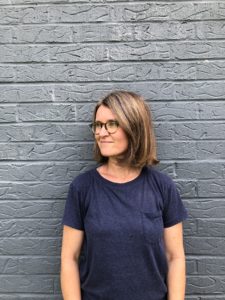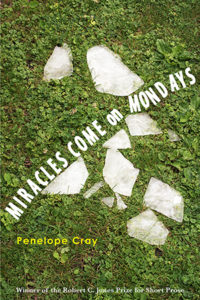Penelope Cray won the Robert C. Jones Prize for Short Prose for her collection Miracles Come on Mondays (Pleiades Press 2020). Here, Cray discusses her new collection with University of Central Missouri student Ashley Herndon. Please visit LSU Press to order a copy of the book, or it will be available for purchase through Pleiades Press, as the press returns from a COVID-related hiatus, on June 1.
AH: Throughout your award-winning collection, Miracles Come on Mondays, words seem to flow from one story into the next, or are revisited later on in a similar context. For example, in the first piece, “Mountain” ends with “this from that,” and the next story is titled “This and That.” We see something similar happening in the second section as well. What was the purpose behind this repetition? Was it done consciously?
PC: I love this question for how it captures two often independent stages in the life of a book: the generation stage and then the selection and arrangement of the works that become the manuscript. My obsessions as a writer become apparent to me through the pieces I write. I’m interested in origins, in breaking complicated circumstances into elemental parts, in tracking logics to illogical ends—all varieties of distinguishing “this from that.” So the appearance of this phrase across pieces reflects these obsessions, and it likely appeared in works that did not make it into the book. For ordering the stories that did make it, I took some advice from a favorite poet of mine, Karin Gottshall, to look for relationships between the pieces at the level of language, as a way of building a sense of narrative inevitability. That’s how I got from “this from that” to “This and That” and how some of the color relationships unfolded in the second section. In this way, the book, like the works during their revisions, guided its own shaping and helped me understand the type of story these pieces could tell collectively. I find that poems and stories have wills of their own. After I’ve drafted them into being—like an army?—I try to stay attuned to the tale they are already telling, to cut away interference so that it can become clearer in its intentions.
AH: All of your stories in this collection are concise and straightforward. What does your revision process look like to achieve this?
PC: My stories often begin as a sentence I overhear in my mind, and I’ve learned to write those sentences down when they arrive. If I don’t, I lose them; they vaporize like a dream does when you shift your position in bed. As a mother who freelance edits from home, I’m often multitasking and always working to a deadline—and with all of us home together now, doing school and work simultaneously, this has never been truer. So I have to pay attention when a story starts talking to me. The short prose block feels like a breath to me—a single exhale often gets me a first rough draft once I record that opening sentence. I start everything in the notes app on my iPhone and visit often with the pieces I have going. I read them out loud. When revising, I try to build the piece out of itself—when I get stuck, I’ll look at the logics already at work in or suggested by the story and draw them out, maybe by taking them literally or maybe by contradicting them. For the stories that end up working, this process feels quite playful. Then, it’s a matter of fine-tuning sound and rhythm and looking for missed opportunities to explore something still implicit in the telling. I share my work regularly with a group of writers; we’ve been meeting via Zoom since the pandemic began. I’m also exchanging work with two poets every other day—poems/pieces for odd days, we call it—and this has shifted my process a little, since in a way I’m writing to a deadline. I can’t always wait for that first sentence to arrive. I do find, though, that my best stories still begin that way, almost on their own and so come, helpfully, with their own revising logic. That’s the fun part—figuring out what they’re trying to say. I’ll move a piece between verse and prose to see what each form suggests, though my work usually ends up in prose. I’ll also change the person of a piece, say, from first to third, to see what “he” or “she” might do that “I” would not.
AH: In “Single Story,” the speaker talks about houses and relationships at the same time in a unique manner. For example, house and relationship can be used interchangeably. What was your inspiration for this story?
PC: This is one of the punnier pieces in the collection, and I really did try to push the envelope on describing the relationships we inhabit using the language of home repair and real estate. I love thinking about houses. For me, different houses propose all the different lives we might be living, based on our having taken this path or that (this or that!). I moved around a lot as a child. By the time I was ten, I had lived in nine houses and three countries—Australia, Germany, and the United States. I’ve felt in my life that the relationships I built in each of these homes, to use the language of the story, have more gaps and ruptures than continuities. Jan’s character in “Single Story” struggles with this, with being unable almost to see what she has/lives inside. Each move, each new home, of course, offers the chance to start fresh, to reinvent/escape the self. And yet the new home, the spirit and intention of its architecture, shapes the lives that unfold inside it. I live in a 1970s “raised ranch,” itself a misnomer for the bi-level, invented as a sort of modern home for all, affordable, open plan, and now, some say, the most maligned style of architecture in America. And yet I’ve been surprised by how much we’ve remade our home “in our own image.” It is a hardworking house; no rooms go unused, though unlike Jerry in “Single Story,” we still have the popcorn ceilings. I like to hope my stories can be like that, too—tight, hardworking boxes in which something of value unfolds.
AH: Throughout this collection you approach various different topics and themes. Your writing is lyrical, yet written in prose. How do you classify the genre of these pieces?
PC: I like to think of my pieces as investigations: I’m invested for a time in exploring the logics, emotional life, and implications of a particular set of sentences. This type of investigation in prose feels very playful to me. I’m drawn to work that proceeds via compression and manages to be both understated and a bit outrageous: Lydia Davis’s short prose, Kafka’s very short stories, Gertrude Stein’s experiments in repetition, Russell Edson’s prose poems, John Berryman’s The Dream Songs, and many other contemporary practitioners of the short form in one way or another: Sarah Manguso, Jenny Offill, Maggie Nelson, Amy Fusselman. And yet my MFA is in poetry, and I did write in verse for a long time. Ultimately, though, I’m most alert as a writer when drafting shaped but unbroken sentences—unrelenting, no breaks!—and, for now, I’m happy to apprentice myself to them.
AH: Many of the stories in Miracles Come on Mondays discuss realistic life experiences or emotions. How does your personal experience affect your creative writing?
PC: I do draw on personal experience when writing, though often under the cloak of character or the absurd. While the stories in Miracles are not autobiographical per se, they engage emotional and physical states I’m familiar with and dogged by, and I write and revise toward what feels emotionally compelling to me. One of the drivers of all the moving I did as a child was my father’s difficulties and eventual suicide when I was five. Five months later, my mother and I left Australia, my birth country, to set up home in Germany with a US Naval officer I did not know well. As an adult and a parent, I remain attuned to the effects of and potential for this kind of radical rupture, abrupt turn, or disorientation. I think about the kinds of isolation and loneliness people can suffer, even in the company of others, and to the way sudden change can leave its marks. Stories are good company for people, and writing stories is the best way I know to stay intimate with myself, to know regularly what I am thinking and feeling. I hope my stories can be good company for other people and their own thinking and feeling. This kind of intimacy feels very protective to me, supporting other daring and recalibration, which these uncertain times will continue to require of us. Writing stories out of this time is helping me live through it more wholeheartedly.
 Penelope Cray was born in Australia and was naturalized as a US citizen on September 11, 2018. Her poems and short fiction have appeared in journals such as Harvard Review, New England Review, Bartleby Snopes, elimae, Pleaides, and American Letters & Commentaryand in the anthology Please Do Not Remove (2014). She holds an MFA from The New School and has been a fellow at the Vermont Studio Center. She lives with her family in northern Vermont, where she runs an editorial business.
Penelope Cray was born in Australia and was naturalized as a US citizen on September 11, 2018. Her poems and short fiction have appeared in journals such as Harvard Review, New England Review, Bartleby Snopes, elimae, Pleaides, and American Letters & Commentaryand in the anthology Please Do Not Remove (2014). She holds an MFA from The New School and has been a fellow at the Vermont Studio Center. She lives with her family in northern Vermont, where she runs an editorial business.
